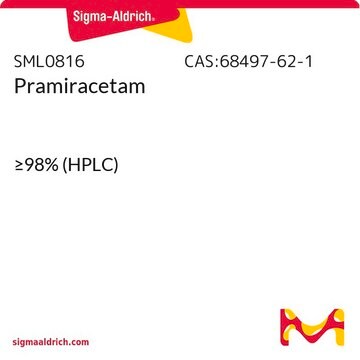S3378
Spironolactone
97.0-103.0% (HPLC), powder, aldosterone receptor antagonist
Sinonimo/i:
4-Pregnen-21-oic acid-17α-ol-3-one-7α-thiol γ-lactone 7-acetate, 7α-(Acetylthio)-17α-hydroxy-3-oxopregn-4-ene-21-carboxylic acid γ-lactone
About This Item
Prodotti consigliati
product name
Spironolactone, 97.0-103.0%
Saggio
97.0-103.0%
Punto di fusione
207-208 °C (lit.)
Solubilità
chloroform: complete 50 mg/ml, clear, faintly yellow
Stringa SMILE
CC(=O)S[C@@H]1CC2=CC(=O)CC[C@]2(C)[C@H]3CC[C@@]4(C)[C@@H](CC[C@@]45CCC(=O)O5)[C@H]13
InChI
1S/C24H32O4S/c1-14(25)29-19-13-15-12-16(26)4-8-22(15,2)17-5-9-23(3)18(21(17)19)6-10-24(23)11-7-20(27)28-24/h12,17-19,21H,4-11,13H2,1-3H3/t17-,18-,19+,21+,22-,23-,24+/m0/s1
LXMSZDCAJNLERA-ZHYRCANASA-N
Informazioni sul gene
human ... HSD17B1(3292) , NR3C2(4306)
rat ... Ar(24208)
Cerchi prodotti simili? Visita Guida al confronto tra prodotti
Applicazioni
Azioni biochim/fisiol
Caratteristiche e vantaggi
Nota sulla preparazione
Avvertenze
Danger
Indicazioni di pericolo
Consigli di prudenza
Classi di pericolo
Carc. 2 - Repr. 1B - STOT RE 2
Codice della classe di stoccaggio
6.1C - Combustible acute toxic Cat.3 / toxic compounds or compounds which causing chronic effects
Classe di pericolosità dell'acqua (WGK)
WGK 3
Punto d’infiammabilità (°F)
Not applicable
Punto d’infiammabilità (°C)
Not applicable
Dispositivi di protezione individuale
Eyeshields, Gloves, type P2 (EN 143) respirator cartridges
Certificati d'analisi (COA)
Cerca il Certificati d'analisi (COA) digitando il numero di lotto/batch corrispondente. I numeri di lotto o di batch sono stampati sull'etichetta dei prodotti dopo la parola ‘Lotto’ o ‘Batch’.
Possiedi già questo prodotto?
I documenti relativi ai prodotti acquistati recentemente sono disponibili nell’Archivio dei documenti.
I clienti hanno visto anche
Il team dei nostri ricercatori vanta grande esperienza in tutte le aree della ricerca quali Life Science, scienza dei materiali, sintesi chimica, cromatografia, discipline analitiche, ecc..
Contatta l'Assistenza Tecnica.














